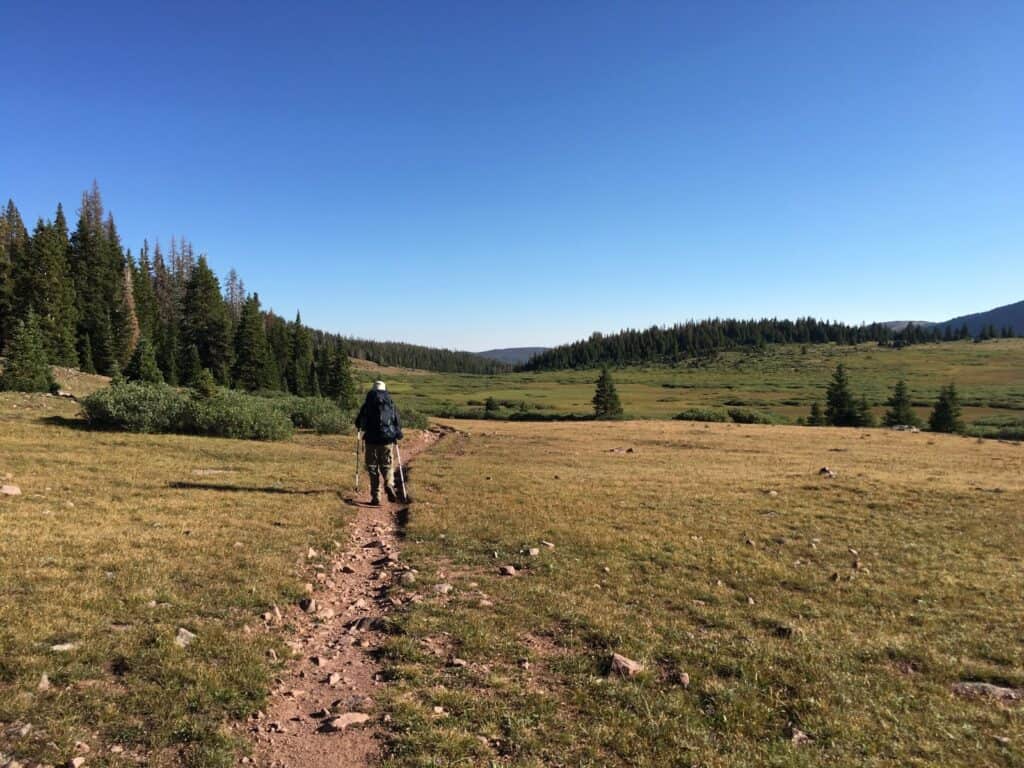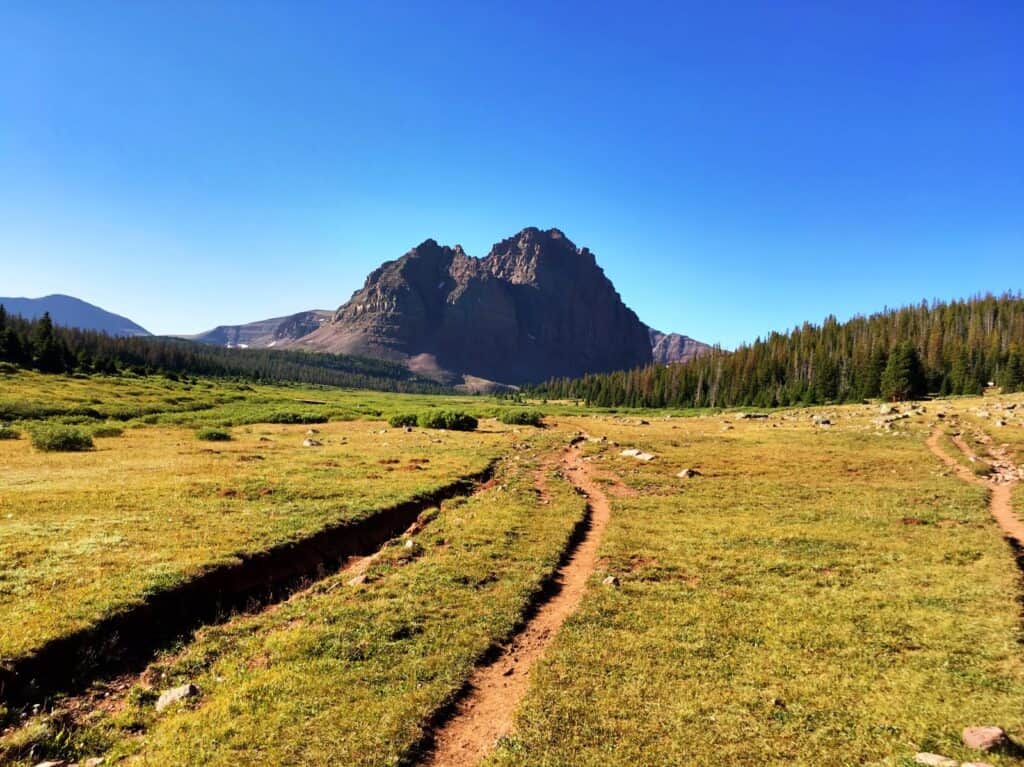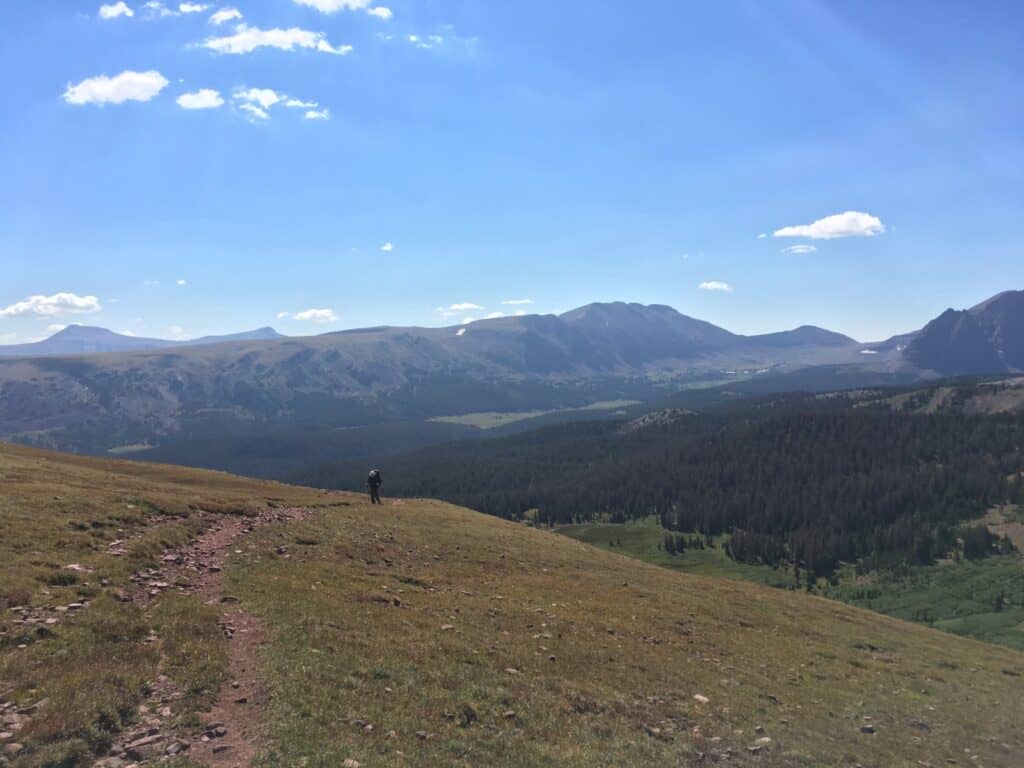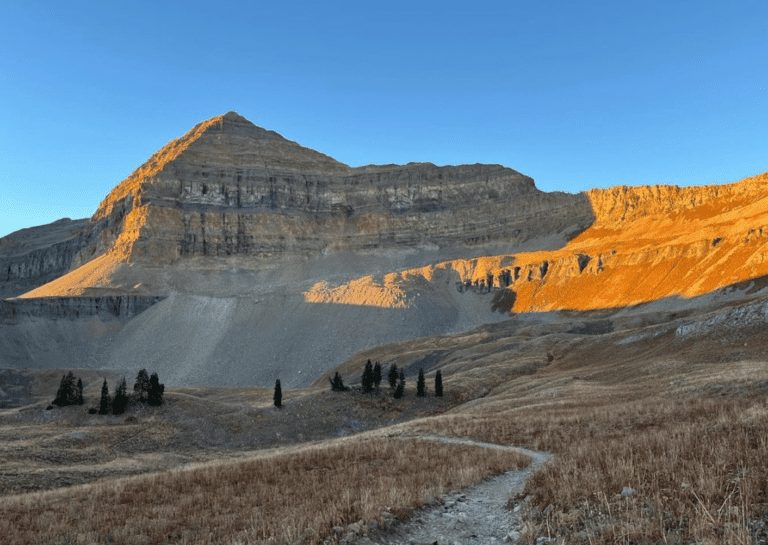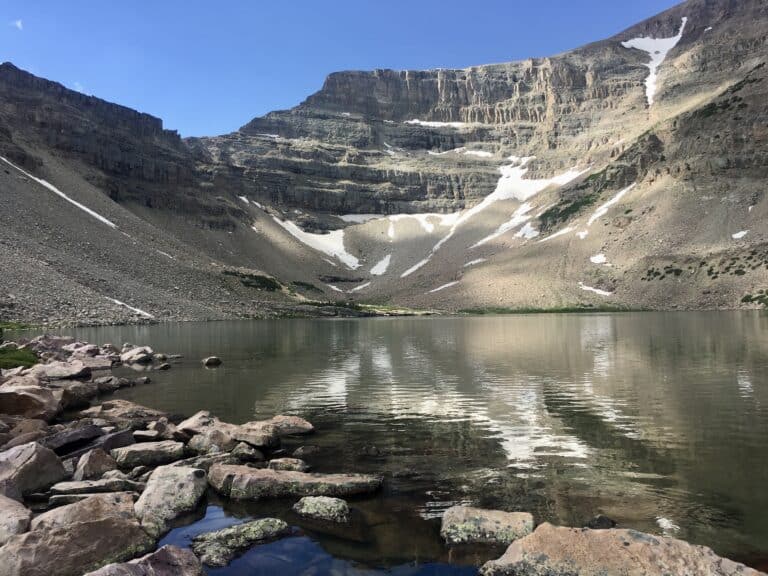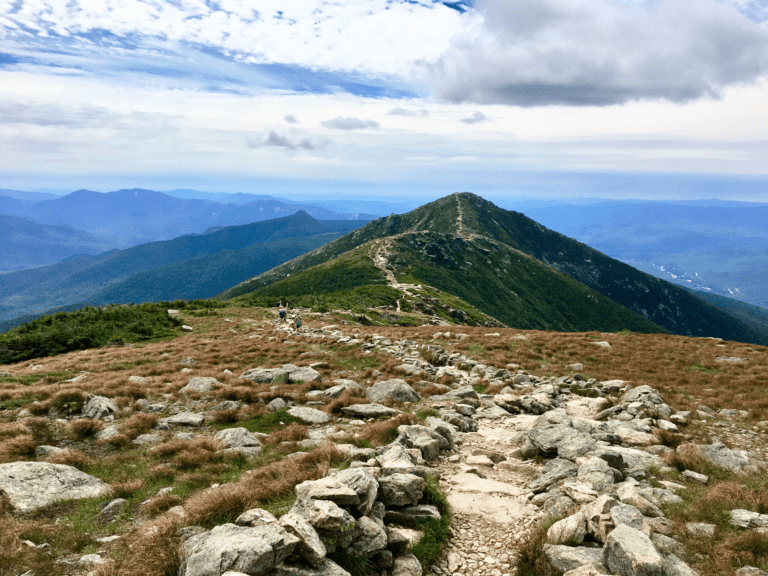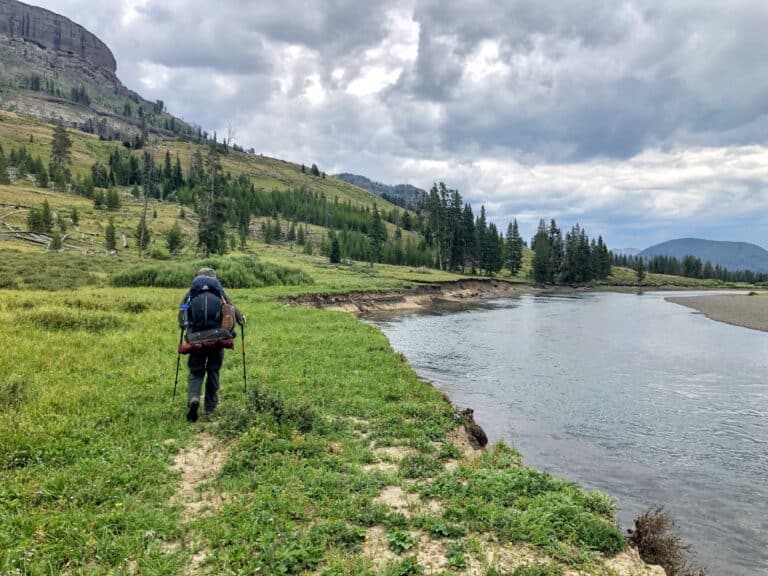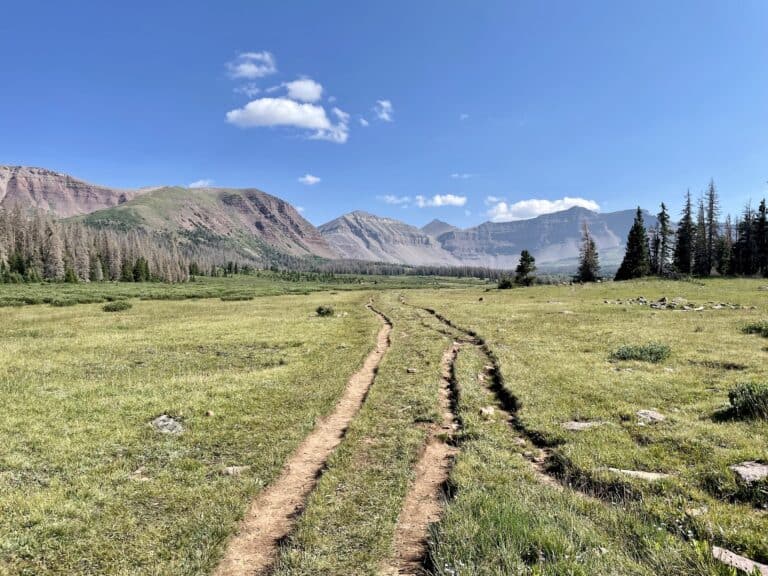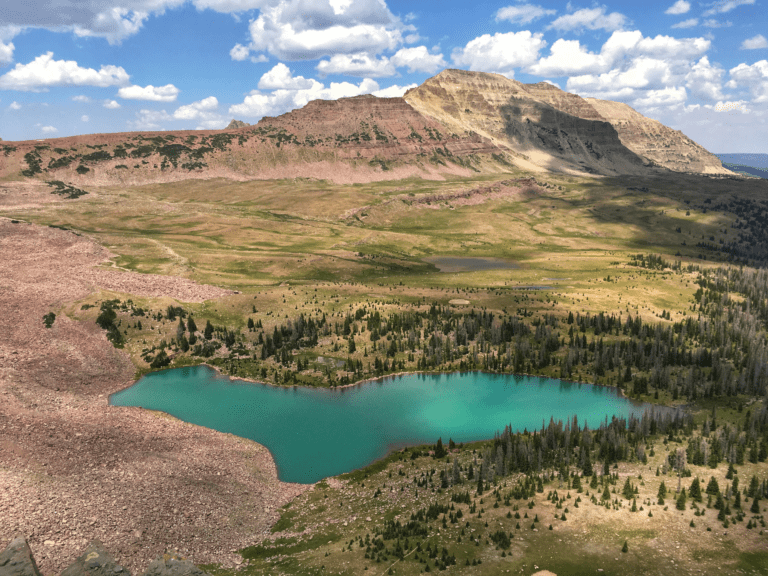I originally posted this trip report at backcountrypost.
Planning
In what has now become an annual backpacking ritual, I returned to the Uinta Mountains in 2017 for another weeklong trip. I had hiked the Uinta Highline Trail the year before, where the logistics of a point-to-point hike were a bit of a pain. In the years since I’ve created a variety of loop hikes to make planning easier.
As I get increasingly familiar with the High Uintas, some trails, and areas are worth repeating from prior years. The goal of every return trip is a mix of the classics and some new places.
Another goal was to find solitude on this backpacking trip to the Uinta mountains. That meant avoiding areas near Mirror Lake Highway. That also means avoiding Kings Peak, the highest point in Utah. Climbing the highest peaks in Utah is a goal, but not for this trek.
In full disclosure, I generally deviate from my initial itinerary in real time and did exactly that on this Uinta mountains backpacking trip. That occurred when we abandoned the Highline Trail deep into Onweep Basin and went over Onweep Pass. The pass that divides the Red Castle area and Onweep Basin is near Porcupine Pass. Even while rewriting this in 2023, this remains the best real-time itinerary change I’ve ever made on a long trek.
Overview:
Trailhead: East Fork Blacks Fork
Distance: 80 miles
Elevation: 12,320 feet
Day 0: Car camping at East Fork Blacks Fork to get an early start on the day
Day 1: East Fork Blacks Fork over Red Knob Pass to Deadhorse Lake | 17.5 miles
Day 2: Deadhorse Lake to Ledge Lake (set up camp) and loop part of the Jack and Jill around Lightning Lake | 15.5 miles
Day 3: Ledge Lake to Cleveland Pass | 12 miles
Day 4: Cleveland Pass to Onweep Basin before Porcupine Pass | 13.5 miles
Day 5: Onweep Basin to Lower Red Castle Lake over an Onweep Pass | 11 miles
Day 6: Lower Red Castle Lake to East Forks Black Fork to complete the loop | 11 miles
Trail Map
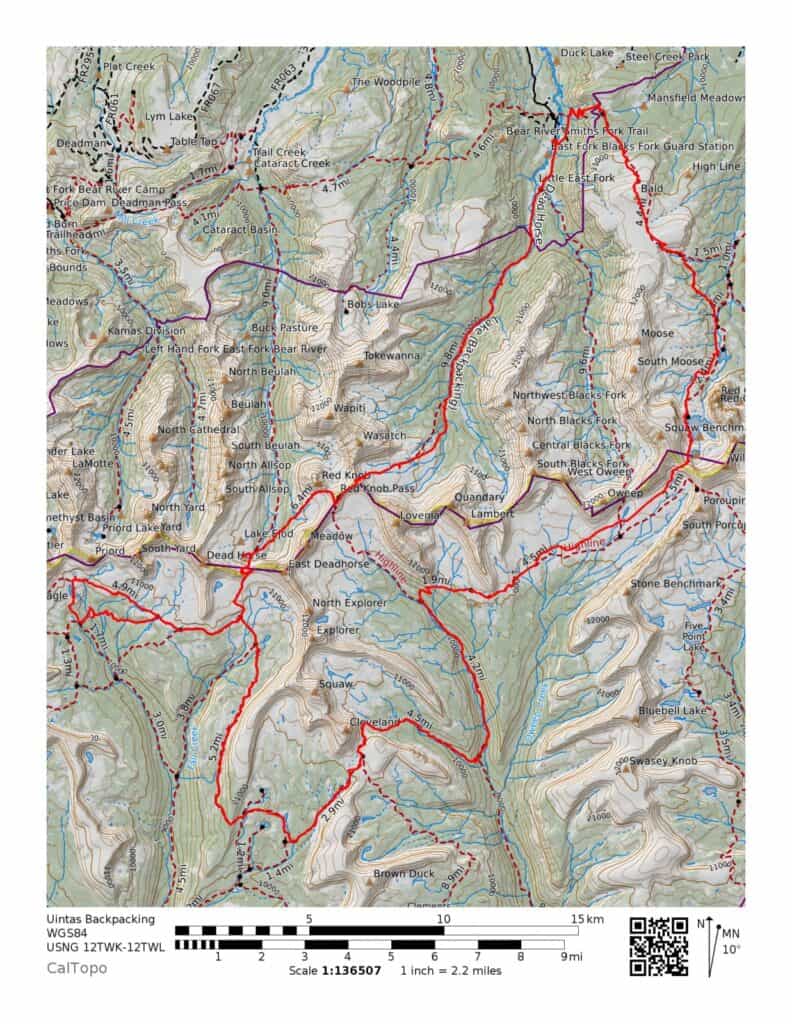
Preparing our Backpacking Gear for the Uintas
Day zero is about preparation and ensuring you have the backpacking gear on your checklist. For many backpackers, the focus is on what they’ll need while they’re out on the trail. It’s also essential to include what you’ll need in your car for the end of your journey.
I recommend packing a cooler full of supplies and using one that keeps ice for at least a week. Ice blocks keep a 12-pack of beer cold and fresh for when you get off the trail. You can also consider some fresh food that keeps well for a week, like sausages, eggs, and cheeses.
Other supplies like dude wipes, a change of clothes, and comfortable shoes also make the list. In a place like the High Uintas, I recommend you be prepared to spend the night after you arrive at your car since the drive back to Salt Lake City can be 3-4 hours from some trailheads.
Our destination is the campground at East Fork Blacks Fork. I drive a two-door Wrangler, which LOVES the Unitas dirt roads. There were plenty of camping spots at the trailhead as the campground was maybe 30% full. In 2022 I used the same campground and trailhead for a different route and found it 100% occupied. The crowded area required us to retreat into the Ashley Nationa Forest to find dispersed camping.
We set up camp, saw a Moose from a distance, had dinner, and enjoyed a campfire as it cools off quickly after sunset in the Uintas.
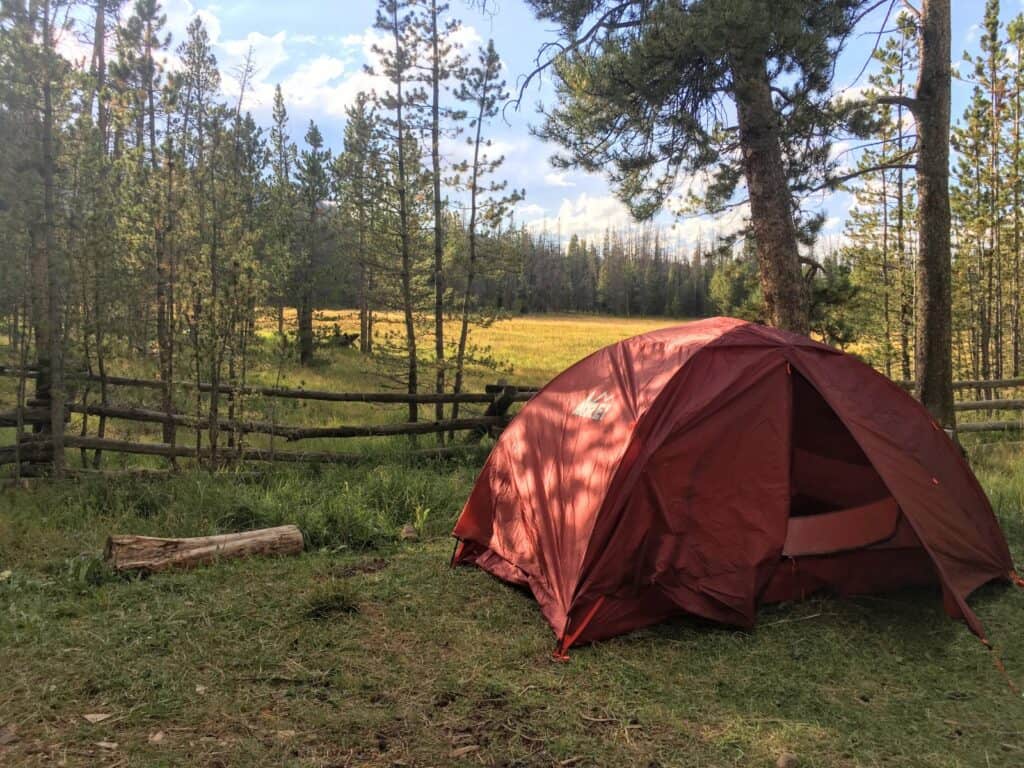
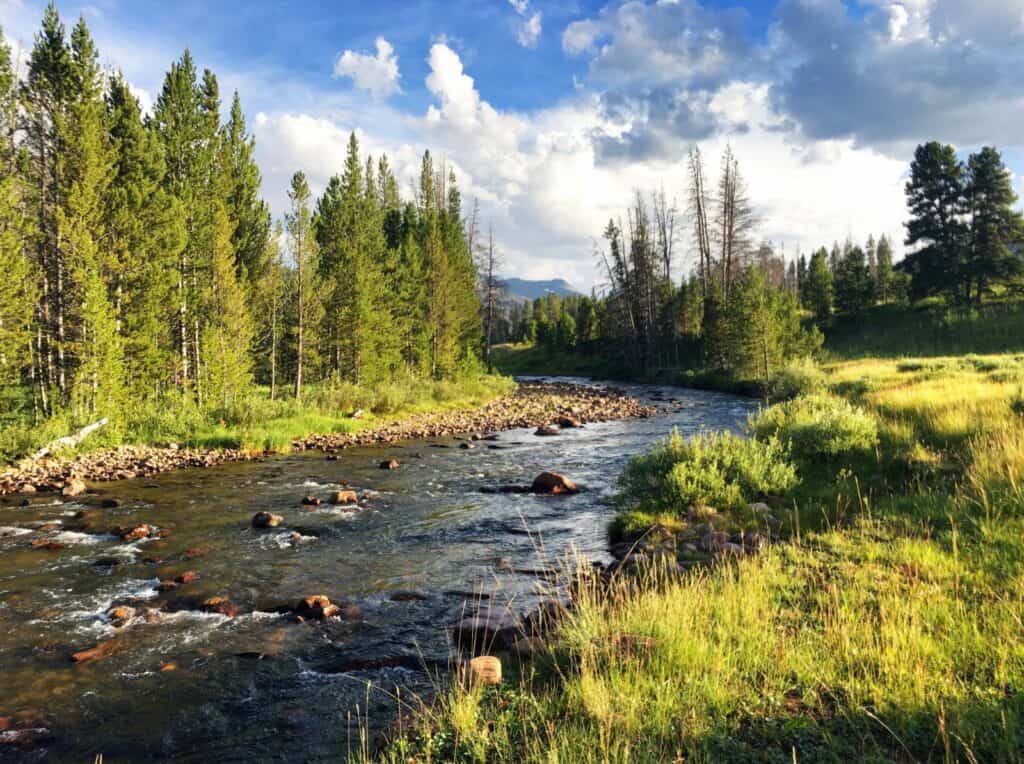
East Fork Blacks Fork Trailhead to Deadhorse Lake
The day begins with a hearty breakfast and the last fresh coffee we’ll have for a week. We pack up camp and relocate the Jeep to the trailhead parking lot.
One of my favorite parts about the Uintas is that you never need to carry more than 1-2 liters of water at any time. The only time I’ve found myself using a second Nalgene is over a pass at high noon or when I’m settled into camp for the night.
The agenda for day 1 is highly aggressive. Hike over 17 miles to Deadhorse Lake. Camping at Deadhorse Lake was an important objective from when we hiked past Deadhorse Lake the year before. That area was the highlight of our Highline Trail trek; unfortunately, we were just passersby. We set a goal to spend a night there in the future so we can enjoy the area. While a few miles further than we’d like, Deadhorse is worth it.
The hike up the basin is stunning. West Fork gets most of the attention, and rightfully so, but East Fork didn’t disappoint. The hike begins in the Wasatch Cache National Forest before entering the High Uintas Wilderness Area, where we’ll spend the next six days.
As we approached Red Knob Pass, the weather closed in on us in a hurry. Big winds and hail greeted us about halfway up the pass. Bad weather is not uncommon in the Uintas, but it was one of those storms that are so fast and brutal you’re too in awe of mother nature to be upset.
The view from Red Knob is outstanding, and coming from the East Fork gives you an additional basin to peer into that you miss entirely when on the Highline. It feels like Deadhorse should come up quickly from the bottom of Red Knob, but on tired legs, with packs at their maximum weight with a week’s worth of food, miles 16 and 17 drag on a bit.
As we hit Deadhorse Lake, we were greeted by one couple and their dog. The rest of the lake was deserted, so finding solitude was easy. I drop the fishing pole into the lake and enjoy the sun setting over the Deadhorse cliff bands. The eastern Uintas are simply spectacular.
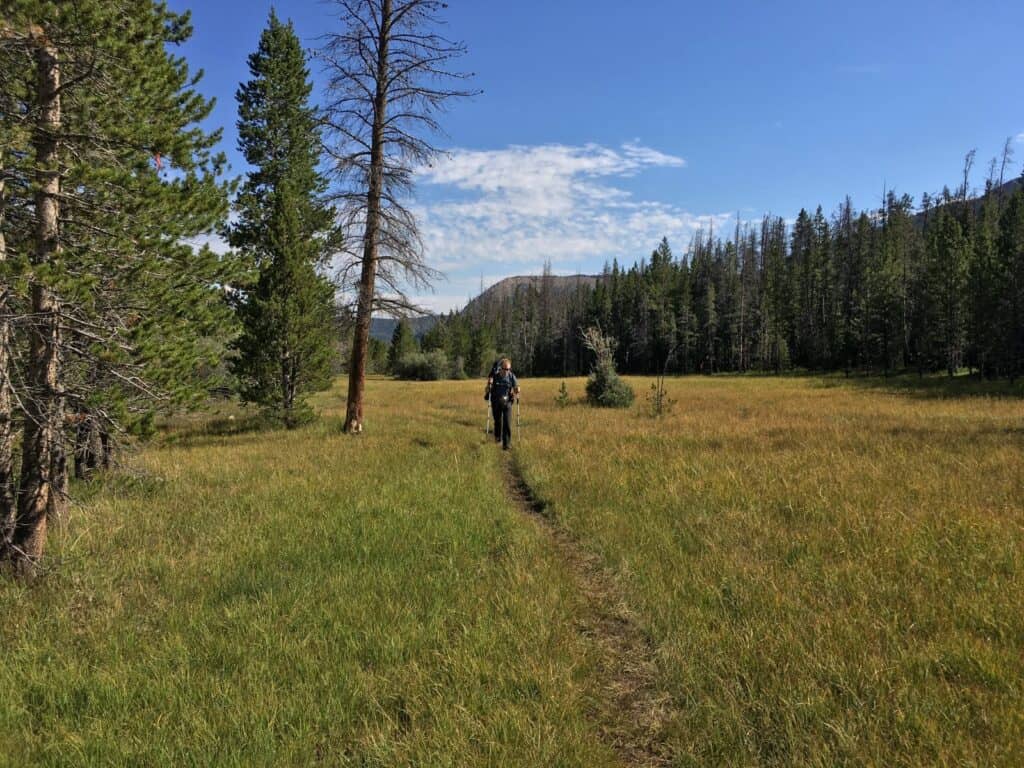
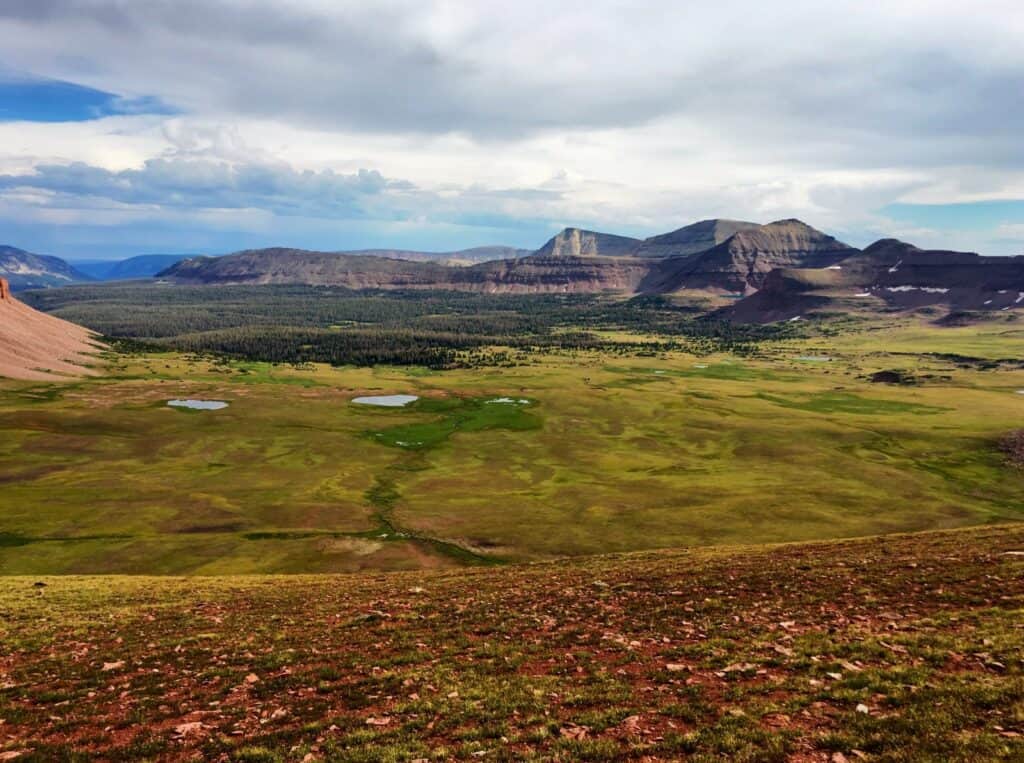
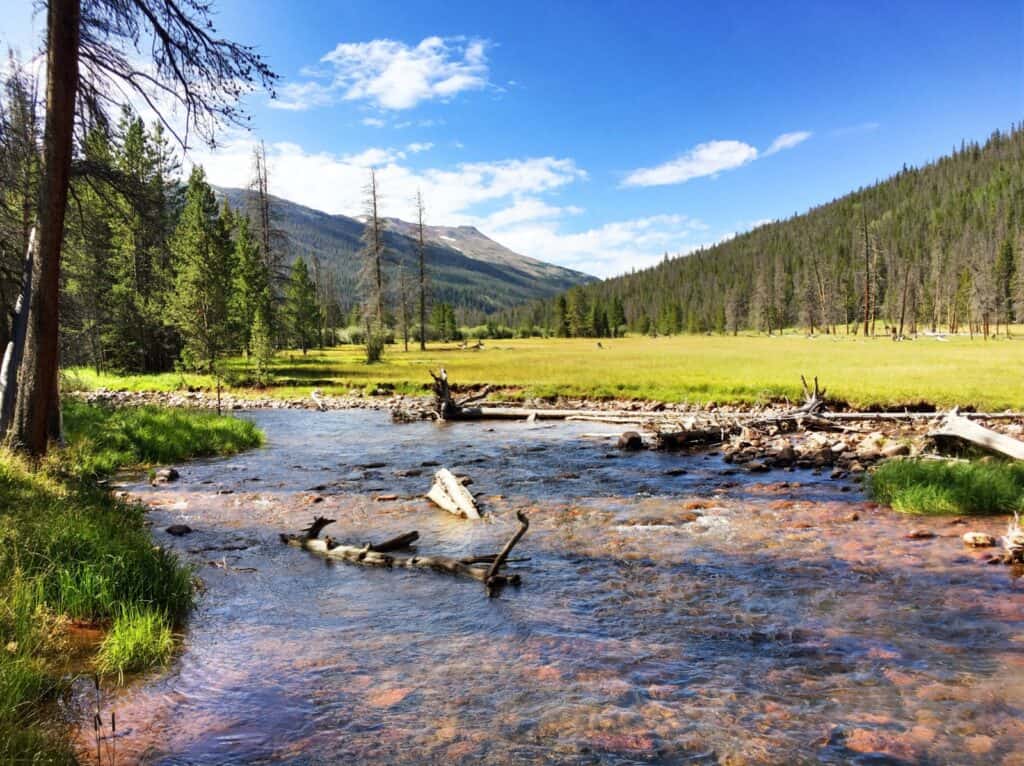
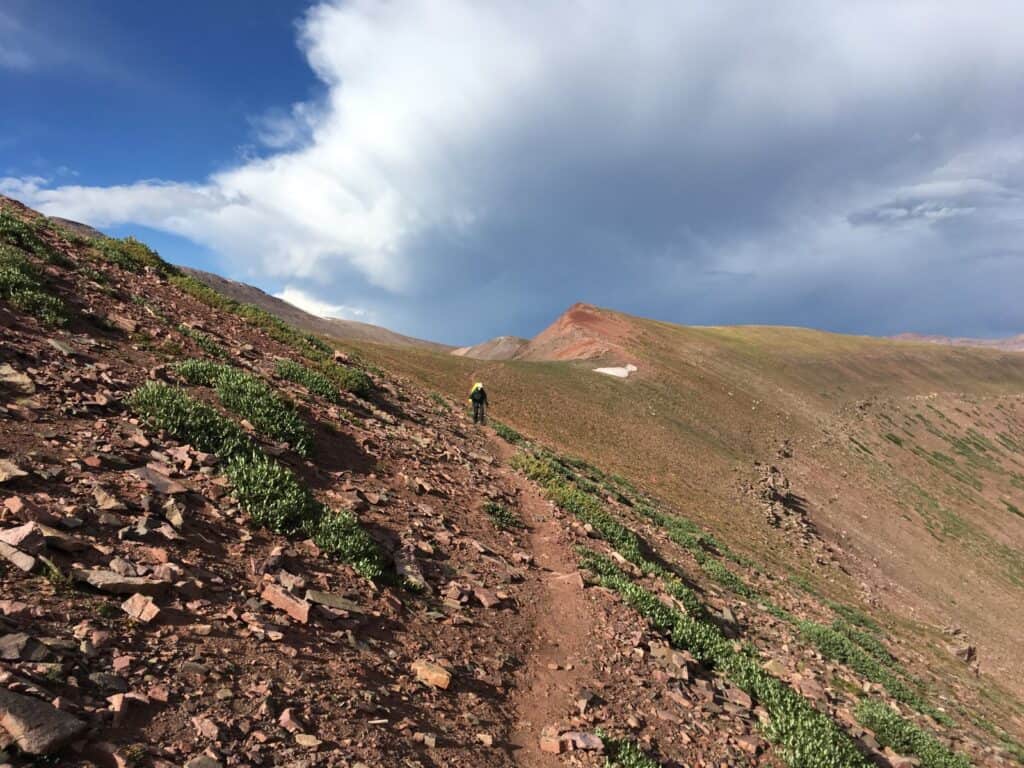
Deadhorse Lake to Ledge Lake
This was a day I had been looking forward to from the moment I sketched out the hike. Climb over Deadhorse Pass early morning, on fresh legs, and before any possible bad weather. After descending the pass, we set up camp at Ledge Lake. Our packs would be light as a feather by leaving behind our sleeping bags/pad, tent, and extra food (properly secured).
The goal from there was to day hike parts of the Jack and Jill Trail, which the Highline embarrassingly skips over. The section of the Highline that runs adjacent to Jack and Jill isn’t nearly as lovely.
We had an overcast hike around the lakes but were fortunate that the sun came out briefly at Lightning Lake. Cloudy afternoons are common in the Uinta mountains, as are afternoon thunderstorms. We were fortunate to avoid bad weather. Lightning Lake was beautiful. I’d love to camp there someday.
We took the trail toward Ouray Lake and the Jack and Jill Lakes. We lost the trail between Ouray and Jack and Jill Lakes and were forced to navigate by map and GPS until we hit Jill Lake. The trails in this area weren’t highly trafficked. This area has a little bit of everything the Uinta mountains offer – alpine lakes, high peaks, and a high country, open meadow feel.
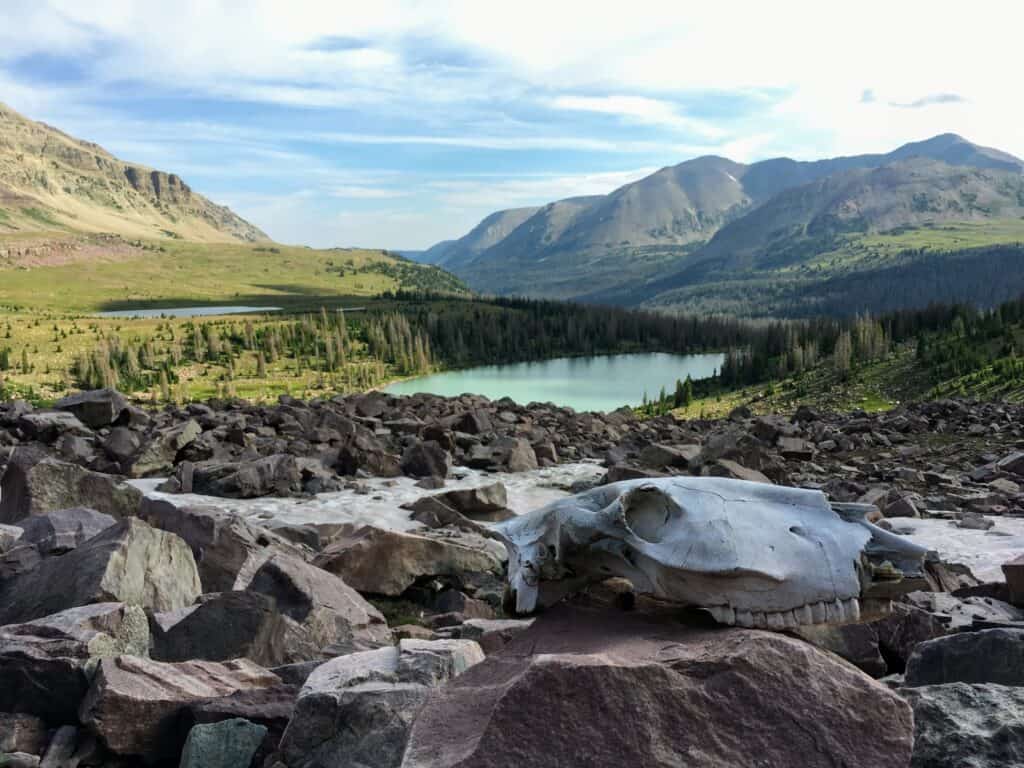
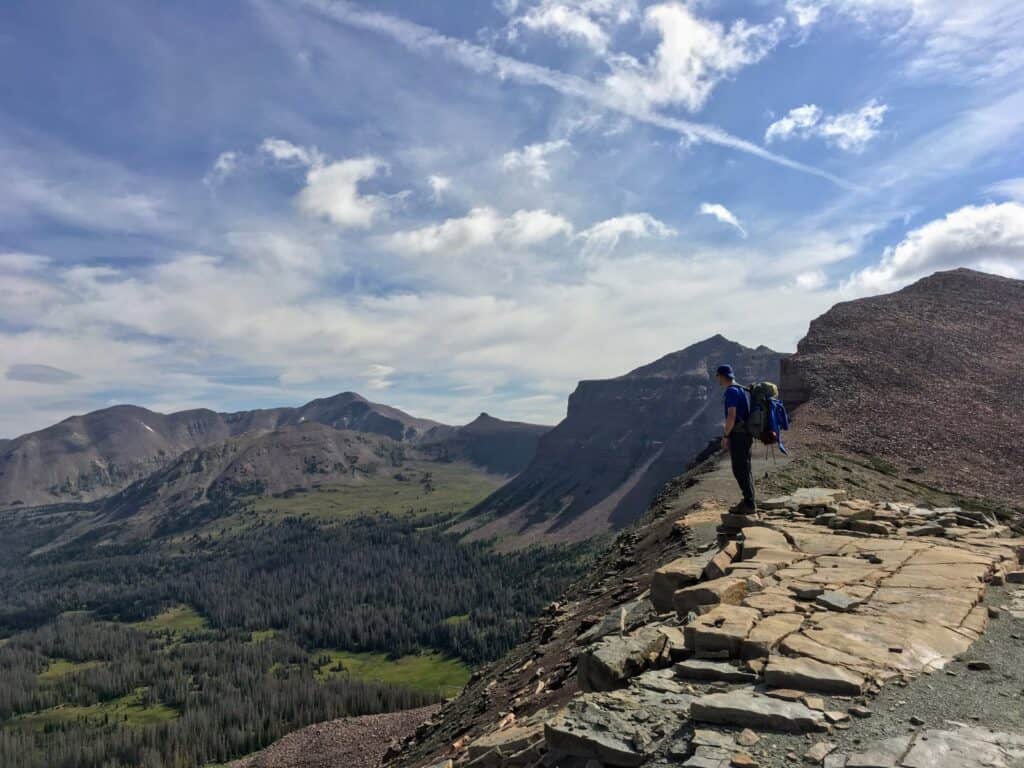
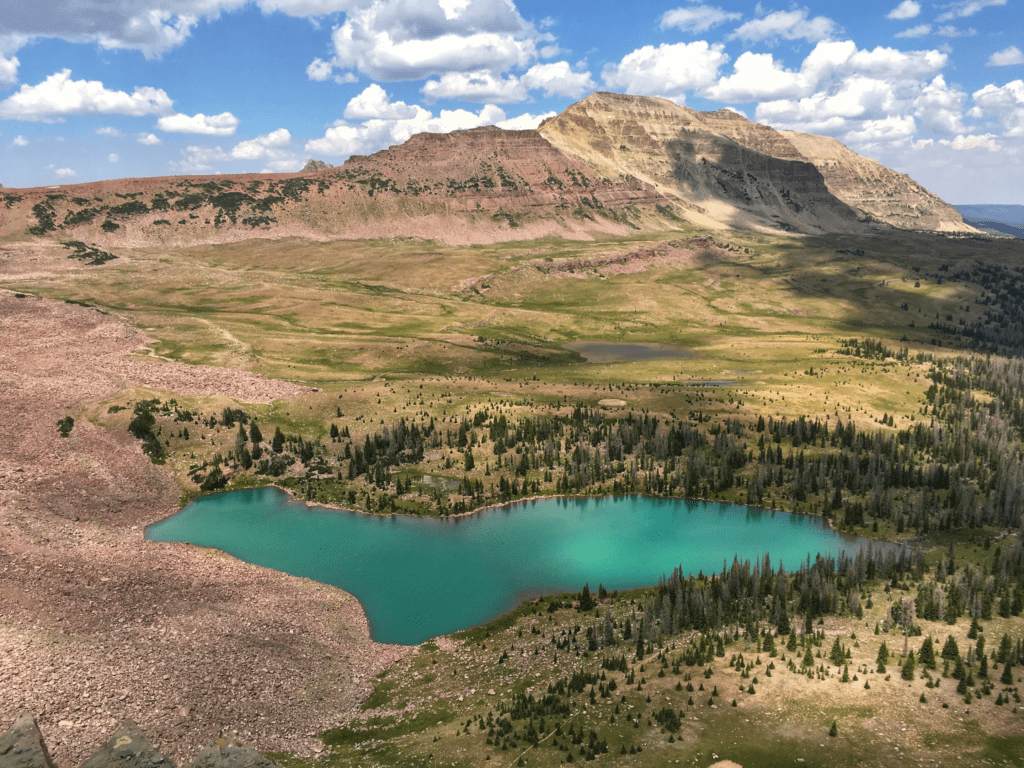
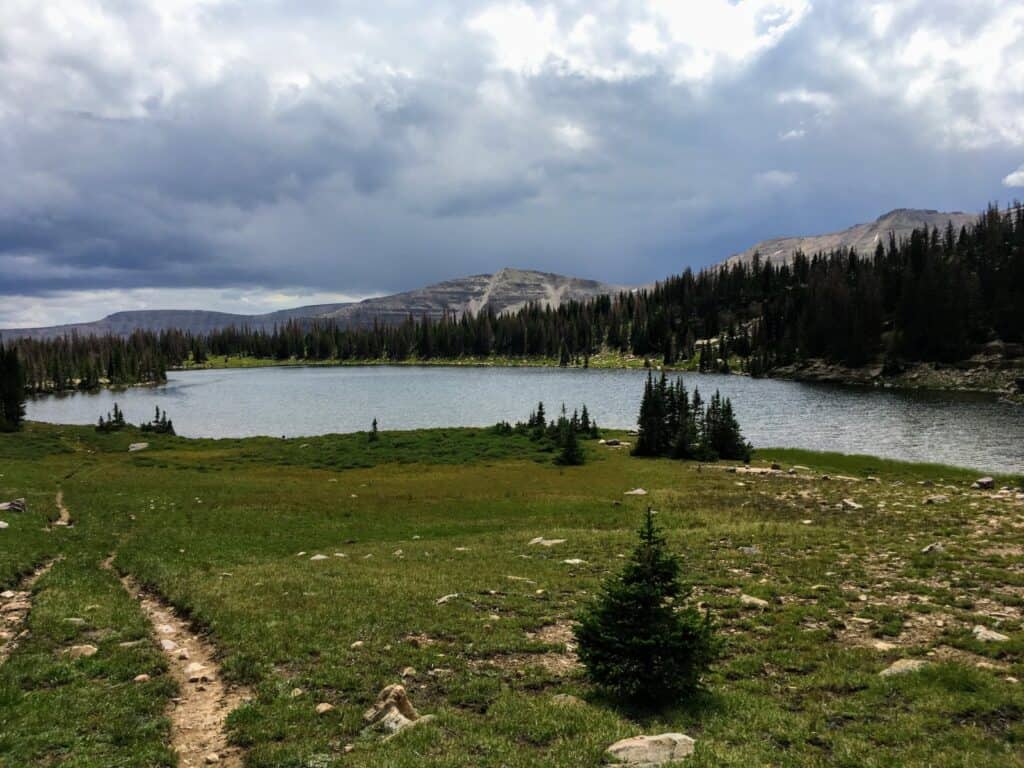
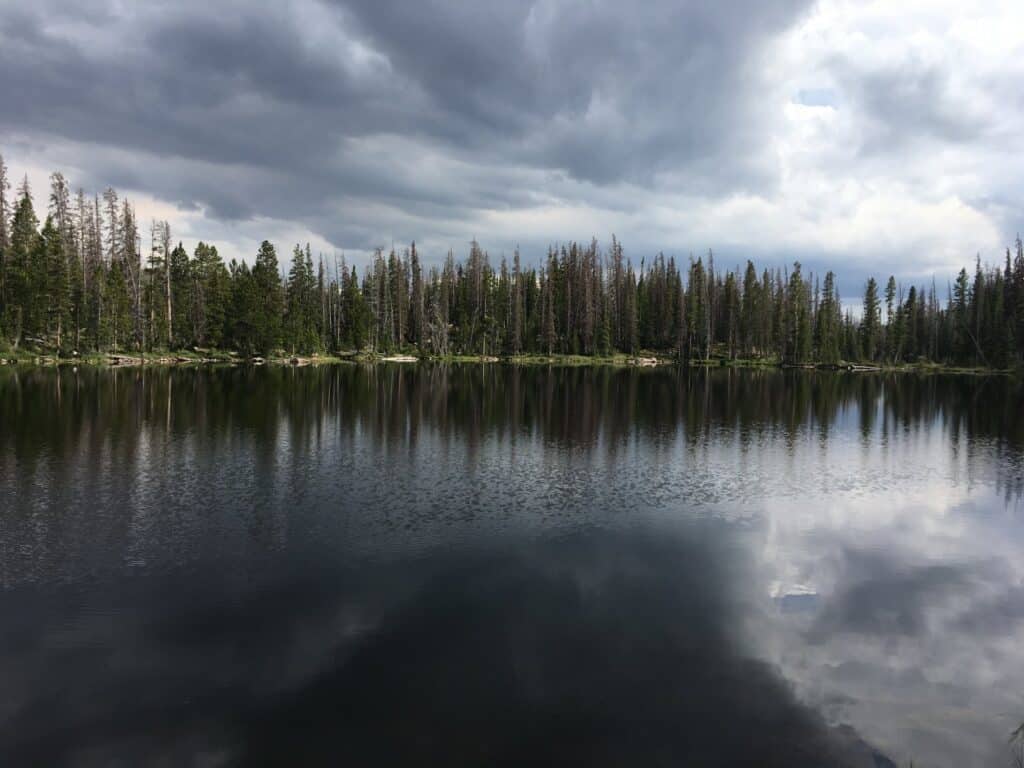
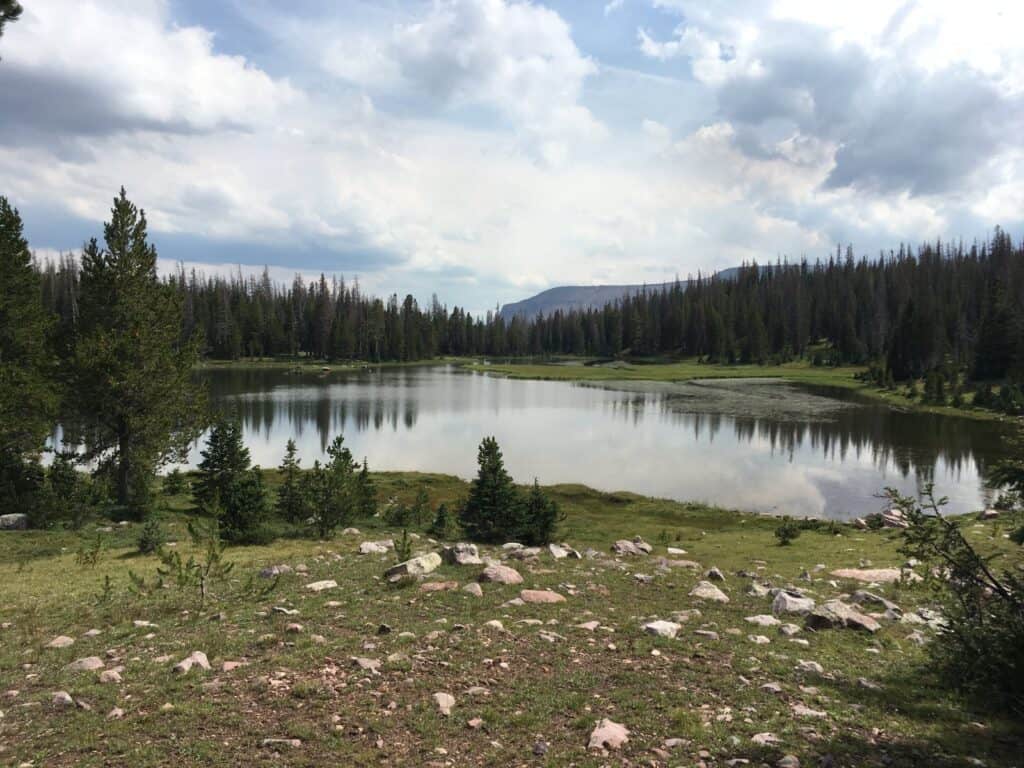
Ledge Lake to Cleveland Pass
Today’s hike would divert us from the Highline as we would head towards Sinowauvf Basin (formerly Squaw Basin) and ultimately up to Cleveland Pass. I completed a solo trip to Brown Duck Basin over the 4th of July and loved the setup of Cleveland Pass and Cleveland Lake. Low and open with just enough shelter from the wind to make camp, and most importantly, I knew there wouldn’t be a soul up there.
Day 2 brought some classic High Uintas solitude as we saw only one set of hikers. The Ledge Lake Trail took us from camp directly into Sinowauvf Basin. Several small lakes off the trail provided accessible resting places, fresh water refills, and great photo opportunities.
At Kyhv Lake (formerly Squaw Lake), we rested and ate lunch. The sun was out, the scenery was impeccable, and it was hard not to leave. We packed the RIE Flexlite Chairs for the first time this year, and since then, I’ve never taken a trip without it. Lounging in those chairs along the flat shoreline of the lake, soaking in the sun, and the Uinta mountains behind it all, was perfect.
We departed Kyhv Lake mid-afternoon and ascended Cleveland Pass. It’s a gradual climb; only the last part of that pass shows any steepness. As you climb, the snowmelt off nearby high mountains like Cleveland Peak takes its own path. It’s a reminder that water always finds a way.
There are no fish in Cleveland Lake. We set up camp near a few scrubs to provide protection from the elements. Cleveland Pass isn’t your typical Uinta mountains pass with a big view but rather a high point with an open meadow and lake. The high country feel, barren landscape, and high mountains make Cleveland Pass a memorable experience.
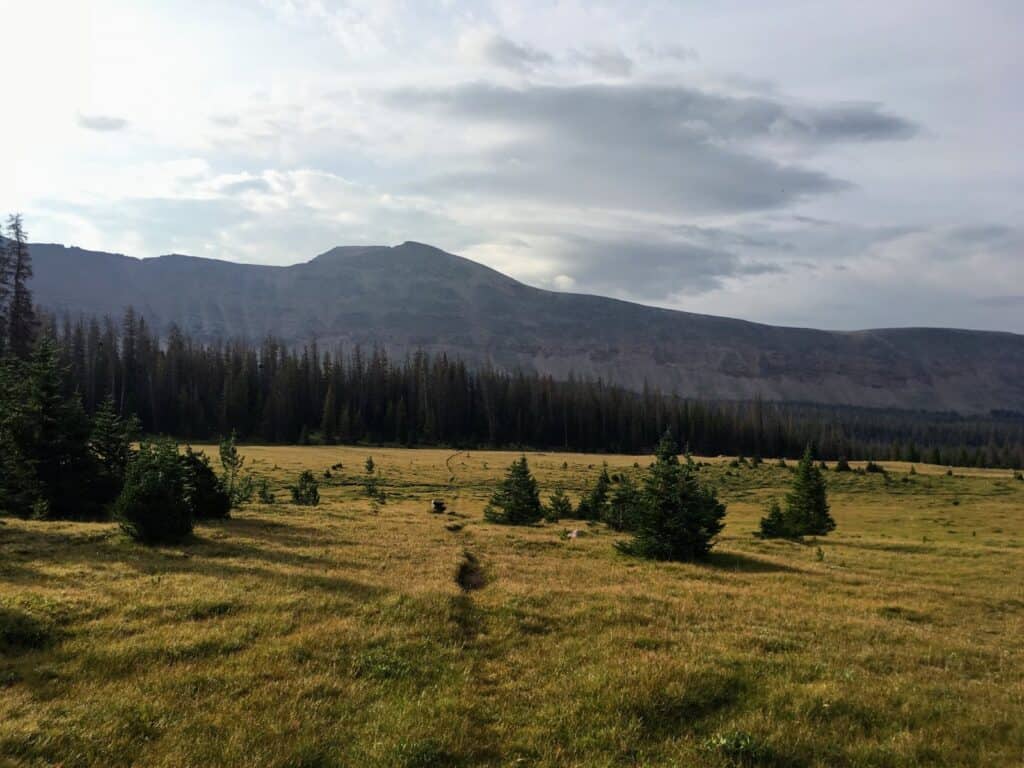
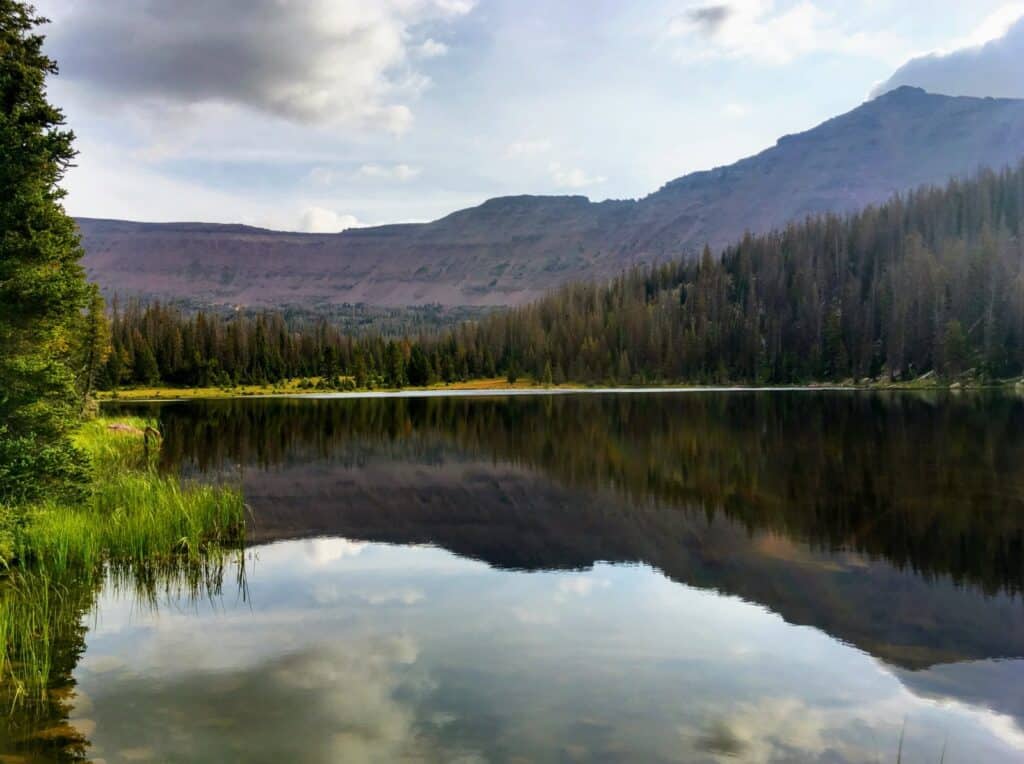
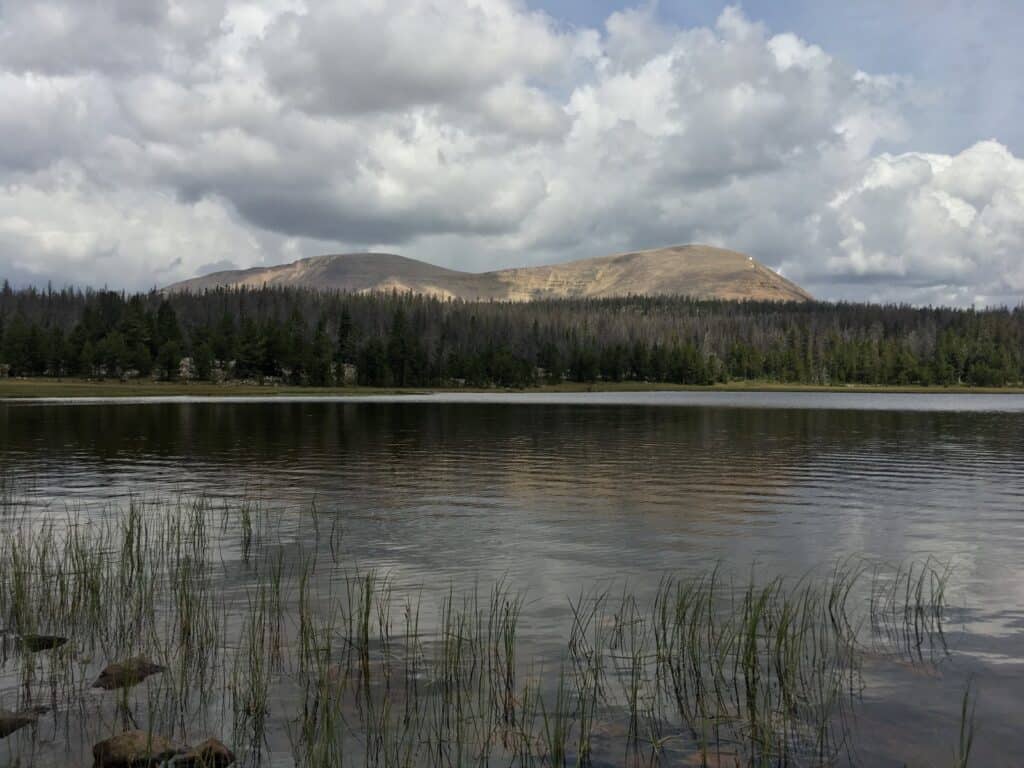
Cleveland Pass to Onweep Basin
We awoke to a chilly morning with frost covering our tent and the meadow surrounding Cleveland Pass. Even in August, the weather can surprise you in the Uinta mountains.
It had been a little stormy the night before, but the morning would bring us full sunshine to help us warm up. The morning reflection off Cleveland Lake was like looking at glass.
The hike today would break up into three sections. First, we began by descending Cleveland Pass along Ottoson Creek. From there, turn north and hike along the Lake Fork River to intersect with the Highline Trail on the east side of Red Knob Pass. And last, we hike along the Highline Trail as our goal was to make it into Onweep Basin before the trees thinned out. Several creeks cross the Highline in this area, so finding one to camp near would be ideal.
The junction at Lake Fork takes you down to 9,300 ft, which means the hike up towards Onweep is slowly uphill. The crossing at Lake Fork is one of the few legitimate bridges in the High Uintas Wilderness Area. We were glad it was there as the river looked menacing to cross.
Once you hit the junction for the Highline, the walk heading into Onweep is one that I enjoy. The trail is surrounded by giant mountains and dotted with reflective lakes. As the forest turns to shrubs, and the shrubs thin out, we make camp.
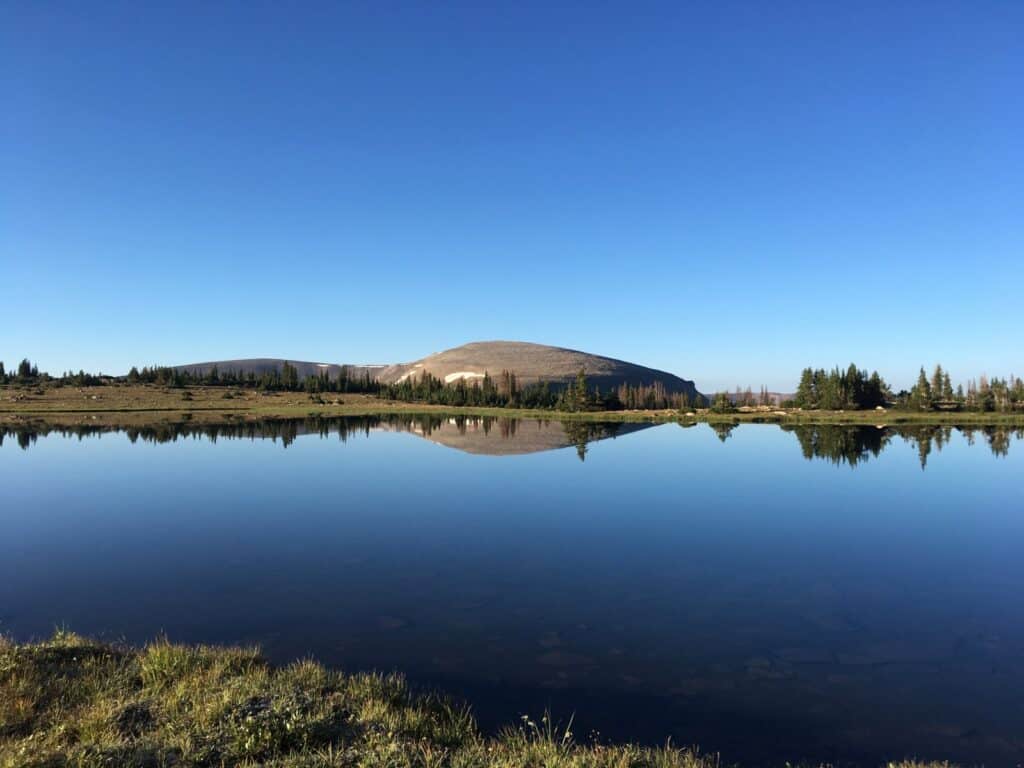
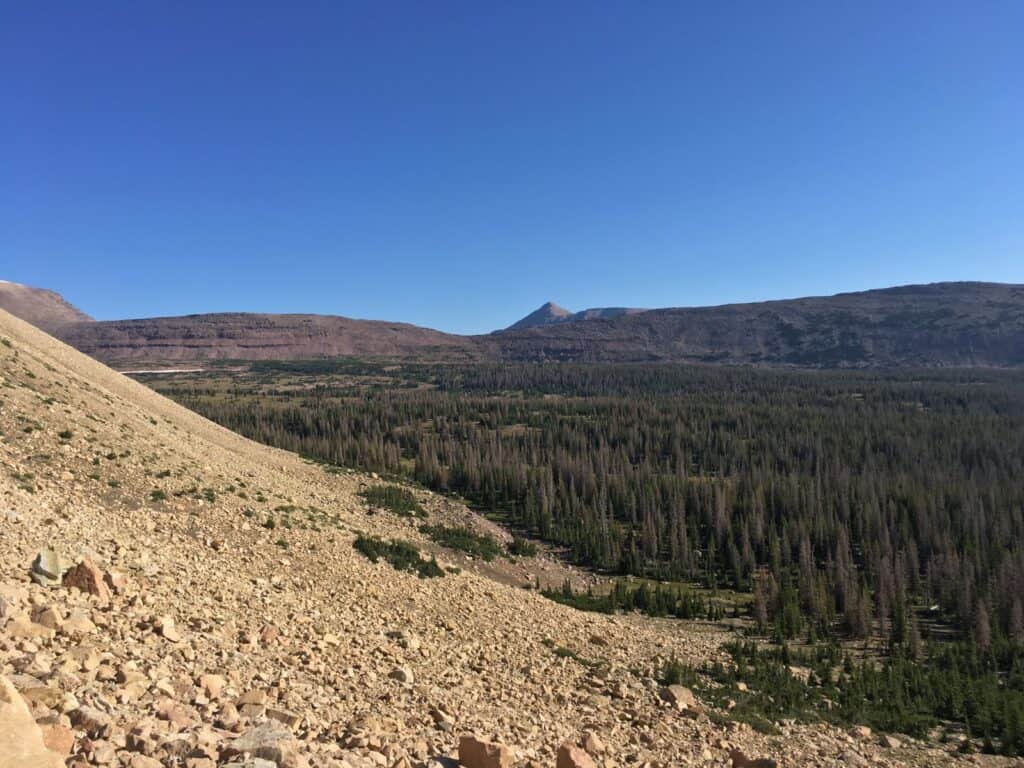
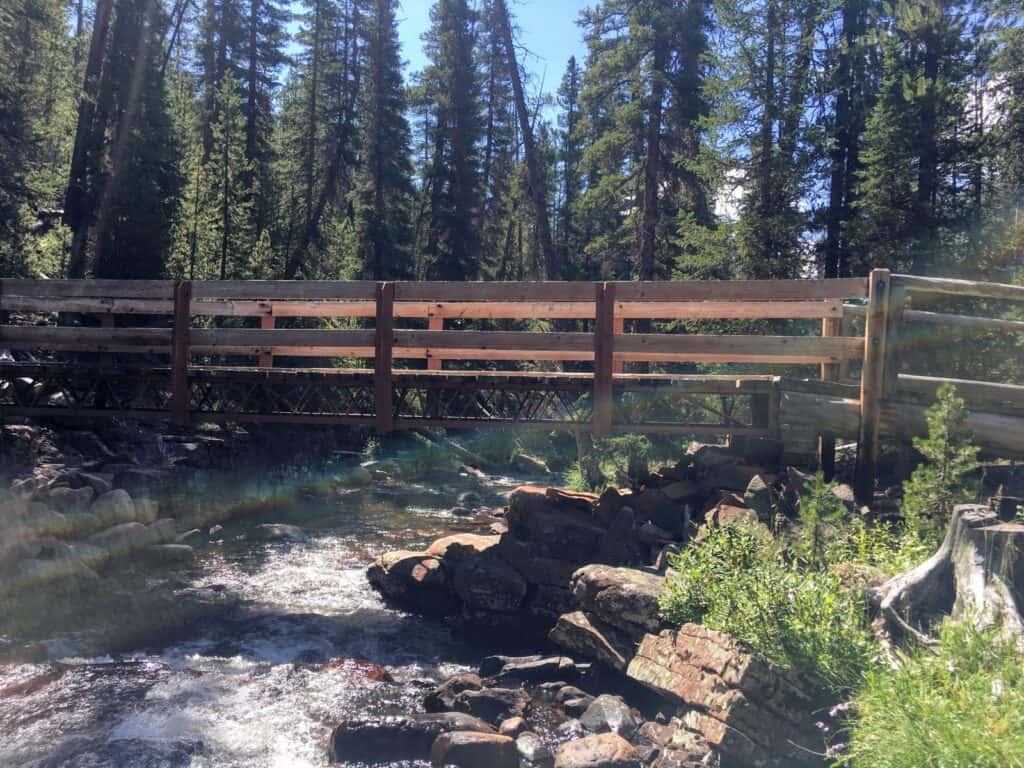
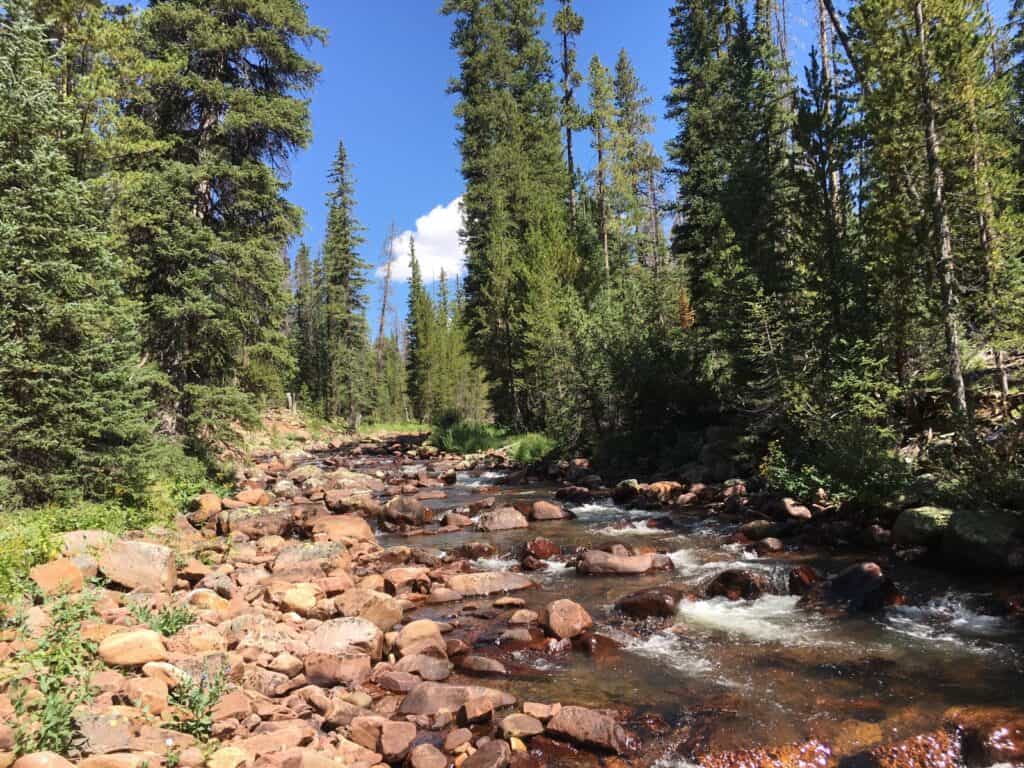
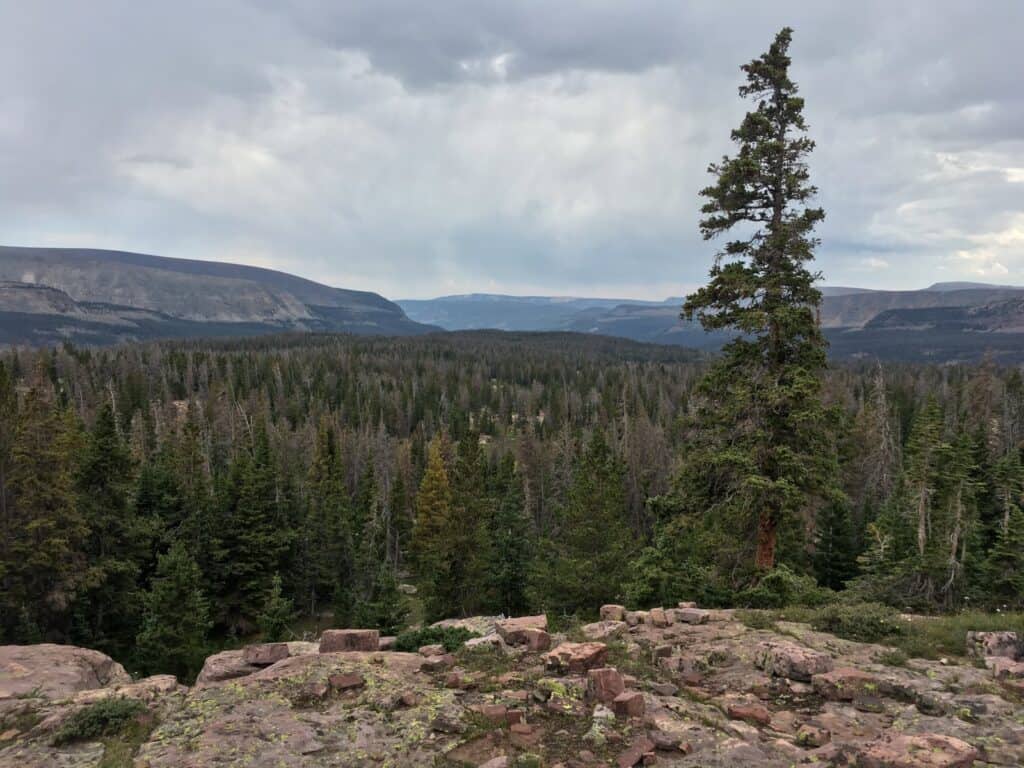
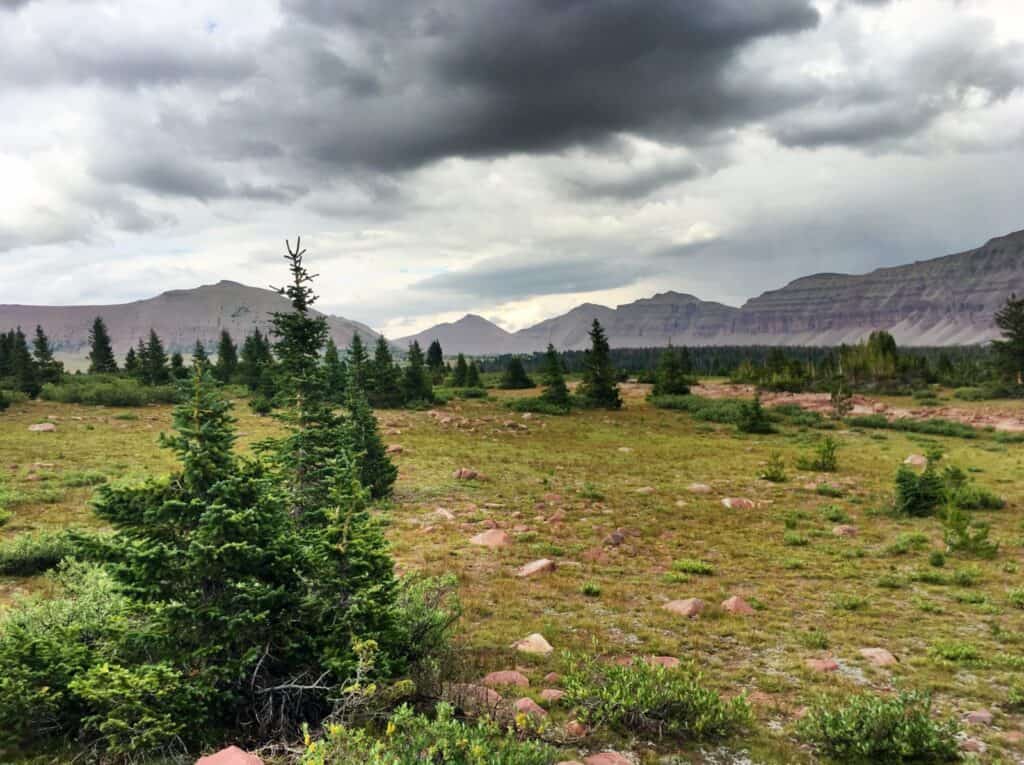
Onweep Basin to Lower Red Castle Lake
Today would be the day we’d call an audible for the ages. Our original plan was to cross over Porcupine Pass and head towards the Five Lakes Region. From there, we planned to hike over Smith-Fork Pass on Day 6, camp on the other side, and hike out on Day 7.
Our change wasn’t because we wanted to end the trip a day early but for three reasons. First, we had already been up Porcupine Pass and hiked in this section of the Uinta mountains. The Kings Peak area was a place we had been to several times. Secondly, the hike towards Smith-Fork looked like Lake Fork, a slow slog. We wanted to stay in the open country. And third, as we planned this hike, we had a few itineraries that took us toward Red Castle, but the mileage on the final day was too much to make an extended stop in the area.
Several written trip reports document hikers crossing Onweep Pass between Onweep Basin and Upper Red Castle Lake. That would be our plan. For those wondering about this as an option, it is entirely doable.
The hike up Onweep Pass is pretty straightforward. There are a few random cairns, but navigating your way up this Uinta mountain pass is mostly a choose-your-own adventure. When you arrive at the top, you are greeted with one of the best views of the Unitas.
The Uinta Mountains Finest: Red Castle Lake
Red Castle, her colors, and adjacent lakes show off their vibrancy. The towering Red Castle peaks provide a spectacular backdrop for Red Castle Lake. Onweep Pass is a worthy place to spend extra time. We ate lunch food, snapped photos, and loitered for at least an hour, just soaking in the view.
The early part of the descent put us on a collision course with a massive herd of mountain goats. Lots of babies, several wanderers, and some concerned mamas. They kept their distance and quickly scurried off towards the cliff bands of Wilson Peak. Watching the mountain goats navigate these cliffs is remarkable.
The only tricky part of this off-trail Uintas adventure is the descent toward Red Castle. There are a series of cliff bands that you have to navigate around. Not cliff bands in the sense of hiking with a lot of exposure, but you’re likely to hit dead ends as you get cliffed out. The challenge is you can’t see more than a cliff band ahead to plan your route. As long as you are patient and strategic, this isn’t a big deal.
Once you hit the lakes, plenty of worn, unofficial trails takes you where you want to go. I dropped my fishing pole into Red Castle and had some success. I watched Cutthroat after Cutthroat chase my spinner. My biggest problem was that these cutthroats were HUGE, and my spinner was meant for your typical small Uintas variety.
It was clear that the depth of Red Castle Lake kept these guys alive for years. The first one I caught swallowed the spinner so deep that I had to wait until the fish passed out to set him free, as the spinner was lodged well past that set of sharp teeth. This area is a dream for an angler.
Lower Red Castle is the best place to camp. Expect it to be busy, especially on the weekend. There are enough camping spots if you take the time to look but expect to see other people. We found a great perch overlooking Red Castle and Lower Red Castle Lake. More sunshine and a few hours left in the day gave us a chance to relax and enjoy the view.
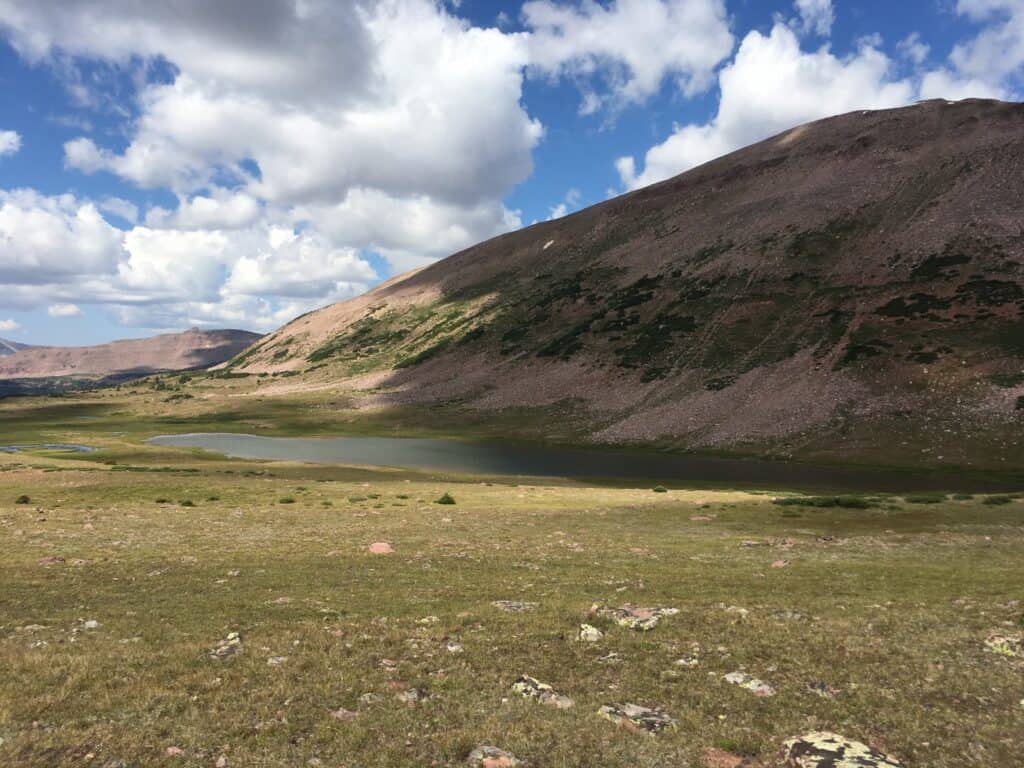
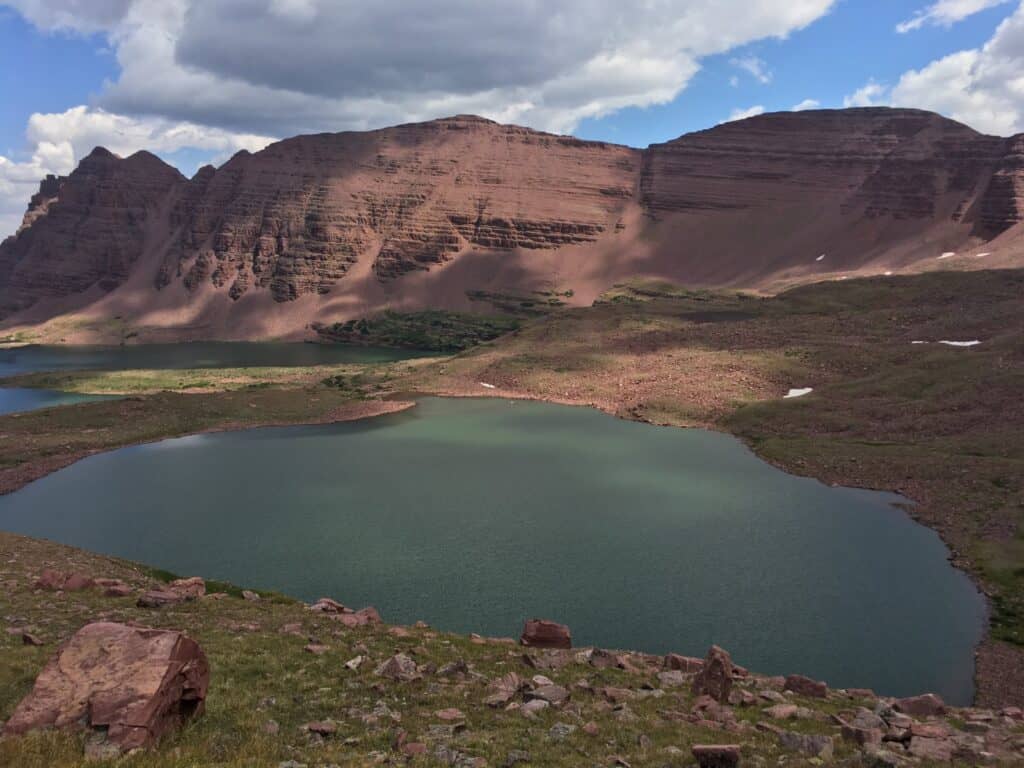
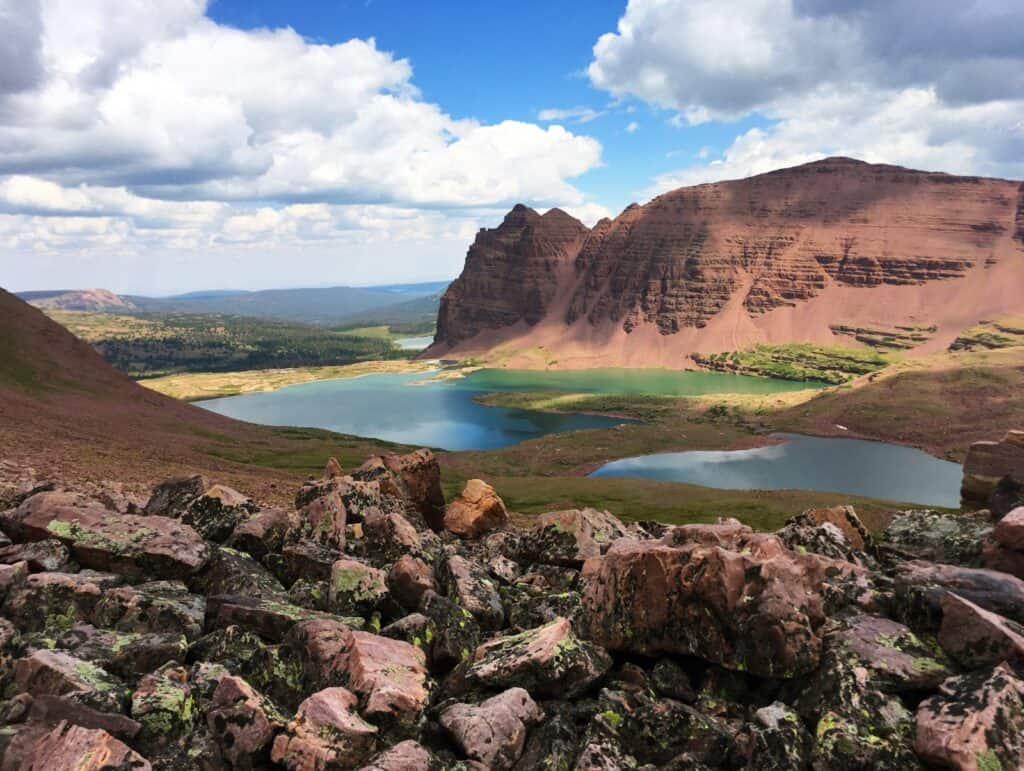
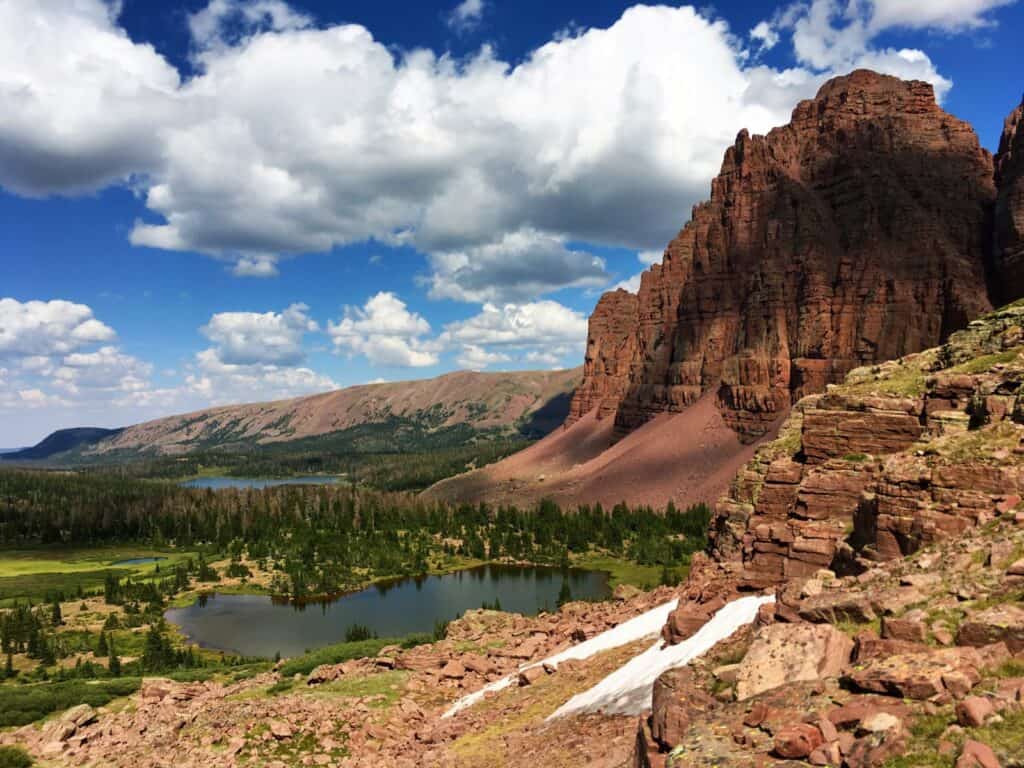
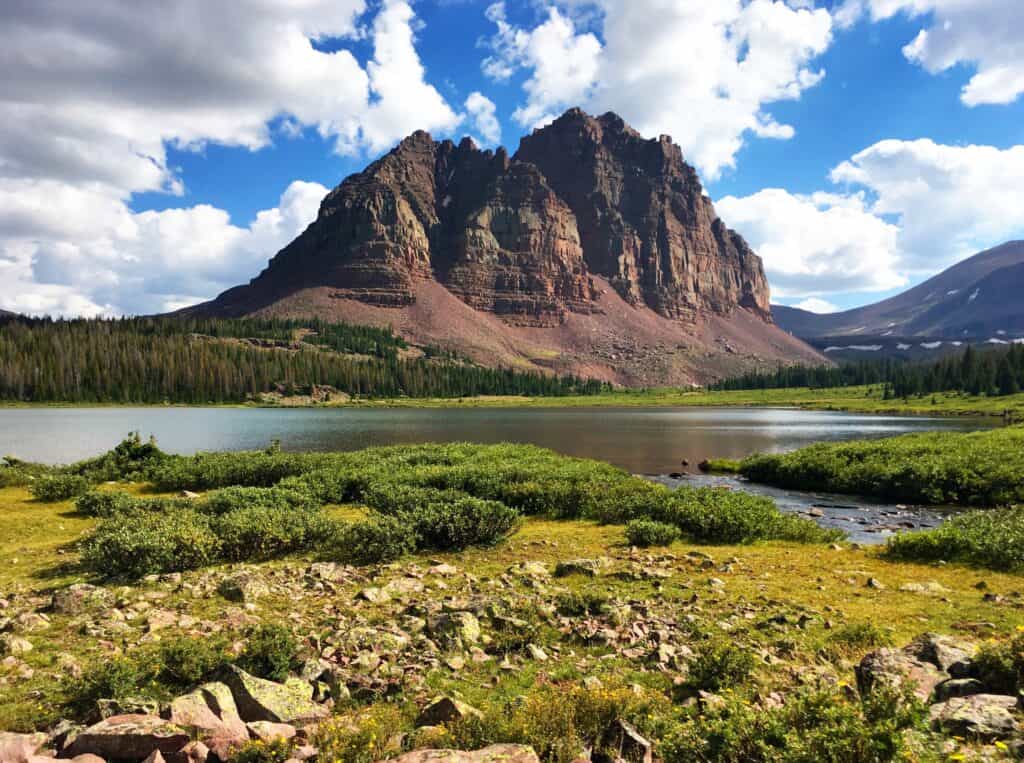
Hike out of the High Uintas Wilderness: Red Castle to East Fork Blacks Fork Trailhead
We were tempted to spend another night in the Uintas at Red Castle. We had enough food to make it another day. Being so close to the Jeep, a cooler of cold beer, fresh food, and clean clothes was too much to pass up.
The hike out of the High Uintas Wilderness was enjoyable as the landscape changed several times. The trek starts by hiking north along the Bald Mountain Trail. The Bald Mountain trail climbs above the treeline to a wide-open tundra. The views are expansive.
One option is to leave the trail to summit Bald Mountain. This is not the same Bald Mountain along Mirror Lake Highway, but a little nub on the top of a long and high plateau. The trail only cuts off the last few hundred vertical feet of the mountain, so it’s worth climbing up.
The Bald Mountain trail ends at a junction with the Bear Rivers Smith Fork Trail that heads towards the two Blacks Fork trailheads. The landscape there changes as you begin to pull away from the heart of the Uintas and leave the High Uintas Wilderness area. The last few miles descend towards the campground.
You can see the trailhead parking lot from far away, but you still have several hours of hiking ahead of you. But soon enough, we arrive, and the beer cooler is a welcome sight. We sat in our chairs and enjoyed the sunshine beating down now that we were at lower elevations. It was the warmest we’ve been in a week. Those cold beers went down easy.
